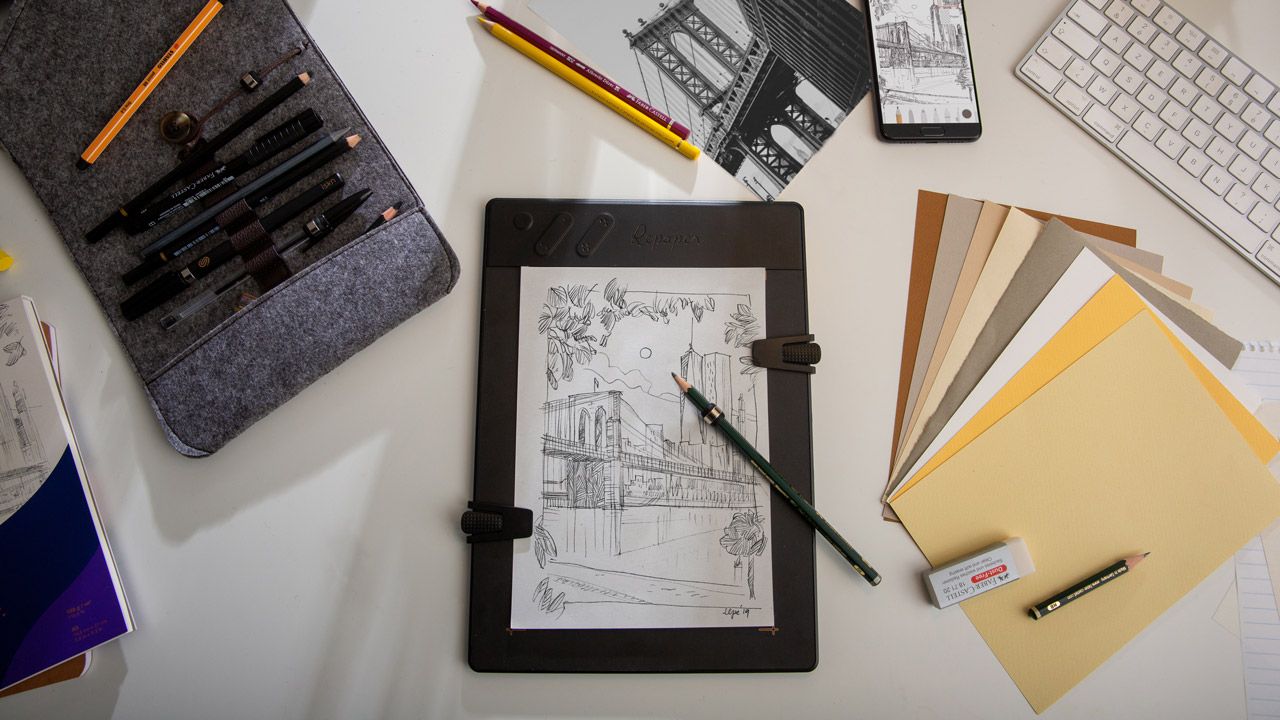
Preparing for Fine Arts Studies: Requirements and Guide.
"To go to the Beaux-Arts" is a phrase that makes many aspiring artists dream. But what are Fine Arts, what courses do they suggest, what to do after these studies, and above all, what are the prerequisites to master to attend these prestigious art schools? We answer all these questions in order to help you better grasp what it is like to study in these institutions of higher education in arts.
What are Fine Arts?
When we talk about fine arts, we usually mention the École Supérieure des Beaux-Arts. These institutions of higher education allow the development of students' professional skills in the art domain, by offering them workshops dealing with numerous artistic disciplines. If originally, the "Beaux Arts" were four in number, with painting, sculpture, engraving and architecture, there are now many other artistic creation modules. There are courses in contemporary art, applied arts, plastic arts, art and design, digital art and visual arts, among other artistic teaching modules. Even if the École Nationale Supérieure des Beaux-Arts de Paris is the most prestigious, there are several dozen public schools of the same type throughout France. Students can also turn to private schools, sometimes also called École des Beaux-Arts, which offer courses that are relatively identical to those found in public institutions.


What are the pre-requisites to enter the Beaux-Arts?
After the baccalaureate, attending the Beaux-Arts is not necessarily automatic for those who have completed their baccalaureate. An application to these schools is not enough, and several criteria must be fulfilled before being able to apply and integrate this post-bac artistic education. Having taken drawing classes or an artistic practice beforehand is already a plus, not to say a necessity, in order to prepare for the entrance exam and hope for admission to the Beaux-Arts. For those who are sensitive to the world of art, but have not had the chance to acquire the necessary skills, other paths are available to them. One can think in particular of the MANAA (mise à niveau arts appliqués), a preparatory year for admission to art schools, offering artistic training over one school year, in order to obtain an equivalence to art studies, which some may have received since their youth. A BTS in design or specialized in a particular field of art can also be a first step to enter the larger schools later on. These courses are more accessible and require a generally lower artistic level than what can be required for the fine arts competitions. Nevertheless, they allow you to train over two years, and to improve your skills during this time. There remains the case of the self-taught. If the latter can still enter an art school after a baccalaureate that has nothing to do with it (scientific for example), it will be necessary in this case that they have had the opportunity to train for several years to prepare themselves for the entrance exam. It can be interesting for them to master the different drawing techniques, but also to acquire an aptitude in digital art, because as we will see later, design or communication courses are offered in this type of school.

They should be able to familiarize themselves with graphic software and graphic tablets, but these tools are sometimes not very accessible without dedicated courses, especially for young people who are sometimes more distracted if the result is not instantaneous. However, there are alternatives that allow students to practice and draw on paper, while benefiting from an introduction to digital technology, with graphic tablets such as the ISKN Repaper, which allows students to place a sheet of paper directly on the operating surface of the tablet, and to draw with their favorite pencils thanks to a magnetic ring, which retranscribes every movement. The drawing is then transmitted instantly to the graphics software, as with any tablet. The advantage lies in the double practice: traditional art and digital art, moreover, there is no need to work on hand-eye coordination at first, which could be discouraging during the initial steps in digital art. All it takes is for future students to come to the application interviews with their creations in digital and paper format to improve their chances of entering the best schools.
What courses can I take?
BAC +3 training courses
After the baccalaureate, high school students wishing to enroll in a public art school may take the competitive examination for art schools. The latter deliver several national diplomas approved by the Ministry of Culture. Among these, we find the National Art Diploma (DNA). With a level of Bac +3, it is an introduction to the subject, and a prerequisite, to go on to a master's degree later (5 years after the baccalauréat). The first year is composed of general modules with general culture, art history courses, and the teaching of all the necessary basics for the following year. From the second year on, the art student must choose one of the three specialized paths offered. There is the art option, providing a generalist artistic education oriented towards art in its purest form, or the design option, turning towards graphic design, object design, product design or space design, among others. Finally, there is the communication option, where all the artistic courses concerning graphic arts will be presented with a pedagogy that will focus on visual communication. If the first year is a sort of preparatory class, the second and third years allow students to combine theory, practice with professionals, and personal projects, in order to obtain the DNA, which confers the equivalent of a license.

BAC +5 courses
Following the DNA, art students can finalize their curriculum by taking the DNSEP (diplôme National Supérieur d'Expression Plastique), which lasts two additional years and is a level bac+5. This diploma, provided by the National Superior Schools of Fine Arts, allows students to work on an in-depth project, which must be presented to a jury via a final thesis. The person awarded a DNSEP will thus be a graduate of the fine arts and will be able to begin his or her professional life as an artist, designer or graphic artist, depending on the specialization chosen in the first three years. It should be noted that the DNSEP is also an opportunity for students to go abroad or to do internships, in order to open up their horizons and acquire useful experience for their future.
What is the cost of attending Fine Arts School?
The choice of training for higher education in arts is wide, and costs can easily vary from simple to double depending on the art school you choose. For public art schools, like all higher education institutions, tuition and fees are around 500 euros. You can, however, obtain scholarships that will lower the cost of admission, thus making public education free. Then there is the case of private schools. First of all, it is important to understand that some schools are recognized by the state, and others are not. It is therefore essential to be aware of the value of the diploma that you will receive after studying art in this type of structure. The price of a private art school can vary greatly. You should consider spending between 3,000 and 10,000 euros per year to enter a school such as these. The cost of the five years is therefore much higher than in public schools, but some schools are highly rated, and have a real reputation for entering the employment world afterwards.

And then...?
Well... It all depends on your major. If you have followed a graphic design curriculum, you may consider becoming an industrial designer, textile designer or space designer, for example. Students who have opted for the communication specialization may consider the careers of illustrator, graphic designer (or computer graphics designer) or why not art director at an advertising agency. The art option, on the other hand, will prepare future painters, sculptors and photographers, but it will also prepare students for museum jobs such as curator or gallery owner. Some schools even offer majors in animation or comics, among others. The choice is therefore vast, and art school, contrary to popular belief, does not only lead to the professions of freelance artist, for which it is true that opportunities are more limited than in communication or digital creation for example.

Art for every taste.
As we have seen, the Beaux-Arts allow for a multitude of studies. From classical art to design and communication, multiple options and specializations are at your disposal as soon as you enter such a school. Knowing the basics of classical and digital art is therefore a real plus for passing the entrance exams, the first year being common and requiring polyvalence in order to be able to choose your specialization in the second year. It is up to you to train well with all the tools at your disposal, and to integrate the most prestigious art schools, having participated in the success of many students.

Discover more
Product design with a graphic tablet.
Design the most beautiful objects thanks to digital technology and the graphic tablet!
Fashion design: learn how to draw clothes
You want to work in fashion, become a fashion designer, and work with a team of designers, but you're still a beginner at making illustrations for haute couture or women's or men's ready-to-wear.
Digital arts: a glimpse of an up-and-coming discipline
Digital art is a generic term used to describe in a common way all the forms of arts calling upon computer or electronic tools, artificial intelligences, and in a general way to all the artistic productions related to sciences and technologies.
Newsletter
Keep up to date with iskn news and events
Free standard delivery
for purchase over $80
30-day returns
on all products
Secure payment
with Stripe & PayPal
Pay in 4
with PayPal
Customer service
chat with us


